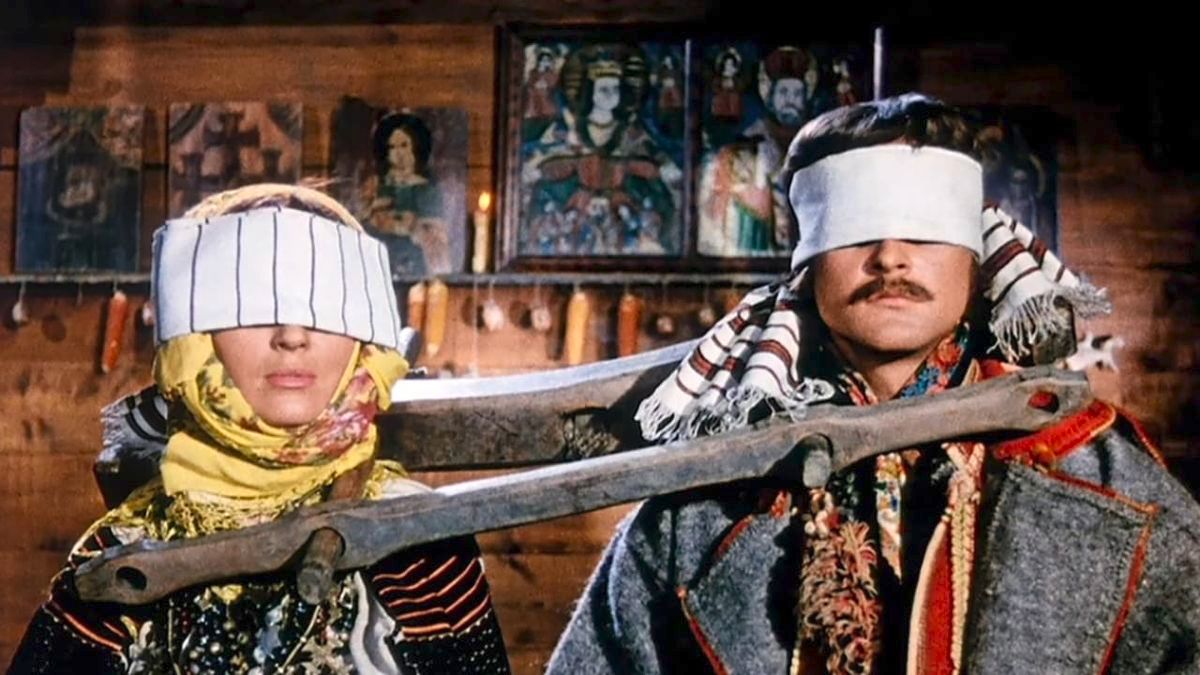"Sergei Parajanov's poetic, pictorially breathtaking films explore not only the history and folklore of the great Georgian director's native land, but also his personal and idiosynchratic universe… His love of music, dance and costumes reached its peak in The Color of Pomegranates (Sayat Nova, 1969)." - Ronald Bergan (Eyewitness Companions: Film, 2006)
Sergei Parajanov
Director / Screenwriter
(1924-1990) Born January 9, Tiflis, Georgian SSR, TSFSR, USSR (now Tbilisi, Republic of Georgia)
Top 250 Directors
(1924-1990) Born January 9, Tiflis, Georgian SSR, TSFSR, USSR (now Tbilisi, Republic of Georgia)
Top 250 Directors
Key Production Country: USSR
Key Genres: Period Film, Drama, Short Film, Romantic Drama, Documentary, Avant-garde/Experimental
Key Collaborators: Sofico Chiaureli (Leading Actress), Marfa Ponomarenko (Editor), Spartak Bagashvili (Leading Character Actor), Mikhail Rakovskiy (Production Designer)
Key Genres: Period Film, Drama, Short Film, Romantic Drama, Documentary, Avant-garde/Experimental
Key Collaborators: Sofico Chiaureli (Leading Actress), Marfa Ponomarenko (Editor), Spartak Bagashvili (Leading Character Actor), Mikhail Rakovskiy (Production Designer)
"Russian director of poetic studies of native folk culture; use of fluid camerawork, vivid colors, symbolic imagery, and wild indigenous music… In 1973, Parajanov was denounced as a nationalist agitator, arrested, and thrown into the Gulag. He was released after four years but prevented from returning to film, and in 1982 was arrested again, to serve a further eleven months. Finally, with the dawn of the Mikhail Gorbachev era, Parajanov was once more allowed to direct." - Richard Bell (501 Movie Directors, 2007)
"One of the most colorful and revered figures in world cinema, Armenian Sergei Parajanov burst upon the international film world in 1964 with Shadows of Forgotten Ancestors, one of the most dazzling movies ever made. A Romeo-and-Juliet tale set in a remote Carpathian village, it is a passionate, richly inventive work marked by breathtaking camera work and stunning color imagery. A multi-faceted artist–painter, musician, collagist, short-story writer, and filmmaker– Parajanov spent more than seven years in prison (1974–1978 and 1982–1985) on a variety of trumped up charges, ranging from homosexuality and spreading venereal diseases to fraud, black marketeering, and "incitement to suicide." After Shadows, Parajanov managed to make only three more full-length films, each astonishing in its own right and each in a completely different style." - Harvard Film Archive, 1999

Shadows of Our Forgotten Ancestors (1964)
"His best-known work signals a profoundly original (if difficult) talent. His idiosyncratic blending of medieval folk-lore with cinematic modernism makes for movies as challenging and obscure as they are sensually poetic… While Parajanov's films are perhaps inevitably obscure for Western audiences, his originality is striking, and the sheer sensuality of his imagery remains both powerful and startling." - Geoff Andrew (The Film Handbook, 1989)
"If there is one trope or technique above all others that seems to characterise and sum up Parajanov’s style, it is surely his frontality: the head-on, squared-up arrangements of elements in the tableaux frame, usually involving a body or a group of bodies in a highly designed décor. These are not the only kinds of shots Parajanov liked to compose – think of the fluid chase between lovers at the start of Ashik Kerib or the many ‘insert’ or ‘portrait’ shots of objects and sections of paintings, which can only be weakly designated as frontal, since they lack the dynamics of space (expanded or flattened space) which matter so much in the Parajanovian tableau. Nonetheless, Parajanov’s penchant for frontality has understandably become, over time, the emblem of his style. And the ‘adventure of frontality’, itself, has become, through and beyond Parajanov, a fascinating, still ongoing episode or thread in cinema history." - Adrian Martin (Film Critic: Adrian Martin, 2007)
"The poetic cinema of Sergei Parajanov does not fit easily into the canons of socialist realism. Graduating from the Moscow Film Institute in 1951, he made a number of films in Kiev before earning a reputation in 1964 with Shadows of Our Forgotten Ancestors, a film filled with wild imagery and influenced by Dovzhenko, Ukrainian folklore and religious mysticism. Its successor, The Colour of Pomegranates, used a similar style to tell the story of the eighteenth century Armenian poet Sayadin. After this, all Parajanov's projects were rejected or halted by the Soviet authorities." - The Illustrated Who's Who of the Cinema, 1983
"I believe you have to be born a director. It's like a child's adventure: you take the initiative among other children and become a director, creating a mystery. You mould things into shape and create. You torment people with your "artistismus" - scaring mother and grandmother in the middle of the night. You dress yourself up like Charlie's Aunt, or as (Hans Christian) Andersen's heroes. Using feathers from a trunk, you transform yourself into a rooster or a firebird. This has always preoccupied me, and that is what directing is." - Sergei Parajanov, 1988
Selected Filmography
{{row.titlelong}}
GF Greatest Films ranking (★ Top 1000 ● Top 2500)
21C 21st Century ranking (☆ Top 1000)
T TSPDT R Jonathan Rosenbaum S Martin Scorsese
21C 21st Century ranking (☆ Top 1000)
T TSPDT R Jonathan Rosenbaum S Martin Scorsese
Sergei Parajanov / Fan Club
Atom Egoyan, Audrius Stonys, Fernando F. Croce, Peter Strickland, Andrew Kötting, Edwin Carels, Matthias Müller, Rada Sesic, Vigen Galstyan, Tony Rayns, Alice Rohrwacher, Roger Koza.
Atom Egoyan, Audrius Stonys, Fernando F. Croce, Peter Strickland, Andrew Kötting, Edwin Carels, Matthias Müller, Rada Sesic, Vigen Galstyan, Tony Rayns, Alice Rohrwacher, Roger Koza.
"Fan Club"
These film critics/filmmakers have, on multiple occasions, selected this director’s work within film ballots/lists that they have submitted.
These film critics/filmmakers have, on multiple occasions, selected this director’s work within film ballots/lists that they have submitted.


